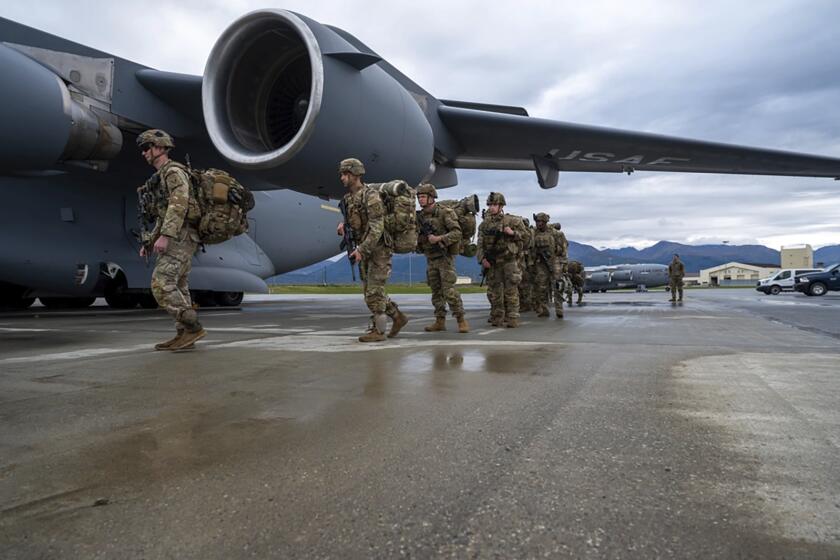China starts three days of mourning
As health concerns intensified and aid poured in from across China and the world, Beijing on Sunday began three days of mourning to commemorate the likely 50,000 deaths from the massive earthquake in Sichuan province.
The toll continued to rise, with a report today by the official New China News Agency that more than 200 relief workers had been buried by mud. Details were not immediately available.
This afternoon, exactly one week after the magnitude 7.9 earthquake destroyed so many lives and communities, China asked its 1.2 billion people to observe three minutes of silence before sounding their car, truck, train, ship and air-raid horns in a collective cry of grief.
China also said it would order all flags to be flown at half staff and would suspend for three days the Olympic torch relay, which is currently on a marathon domestic tour. In recent days, runners have started with a moment’s silence and solicited donations along the route.
China’s missions around the world also were advised to observe the tributes and to offer condolence books for those who wished to express their sympathies.
For the mourning period, the State Council, or Cabinet, also ordered all websites to remove entertainment and game sections and redirect users to pages dedicated to victim commemoration.
On Sunday, China raised the death toll to 32,476 in what has become a daily grim ritual of moving 3,000 to 4,000 from the missing column to the dead column.
Two women were reportedly rescued from a collapsed building at a coal mine today. Three more people were reportedly pulled alive from the rubble Sunday. But the momentum was inexorably shifting from finding the missing to caring for the injured, ensuring that epidemics don’t break out and clearing roads.
The road to hard-hit Beichuan was filled with hundreds of army, government and private relief vehicles loaded with rice, instant noodles, bottled water and tents. “Let’s unite with one heart to fight this natural disaster,” said a sign on a large blue relief truck.
The outpouring of donations created a logistical nightmare as soldiers worked to clear a large area of underbrush on the east side of the road just outside the battered city to store thousands of boxes and pallets, which were unprotected from rain. Periodically, traffic on the single lane dead-end road stopped in a tangle of heavy equipment, cargo and military vehicles.
Some trucks moving from Chengdu, the provincial capital, to Beichuan, meanwhile, carried less-traditional relief cargo, including five tractor-trailer trucks filled to the brim with loose cucumbers. On the road just outside Beichuan, someone had dumped a mound of cabbage, evidently unable to find another place to put it.
In addition to the dead, about 220,000 people were injured, the State Council reported Sunday.
Poon Taklun, 50, an orthopedic surgeon and volunteer with the Hong Kong Red Cross, manned a makeshift medical center in a tent on the landslide-blocked road leading out of Beichuan. It was the first stop for victims who had been buried in the debris or displaced survivors walking long distances from isolated mountain villages.
Poon said the medical infrastructure was gradually improving. “We set up right after the earthquake, and initially many of the more seriously wounded victims came here,” he said. “But they now have a good hospital just up there. We’re just trying to help relieve the pressure.”
On the road a few hundred yards south, four men in surgical masks sprayed a mist of chlorine at the wheels of vehicles leaving the shattered town as a health precaution, the revving pumps sounding like a plane taking off.
Farther south, the Deyang People’s Hospital No. 2 struggled to handle several times its usual number of patients.
“I don’t know how long it’s going to take to heal,” said Zeng Defang, 46, touching a leg wrapped in a bloodstained bandage and swollen to three times its normal size.
“It got smashed when our house collapsed in Hanwang,” she said. “My husband’s brother is still buried. I don’t know how much chance he has.”
Although the presence of bodies is distressing to residents, displaced victims and others in the area, the experience of the 2004 Asian tsunami suggests they do not pose a major health risk, officials said. But the World Health Organization warned today of a growing risk of epidemics compounded by the increasing number of displaced quake victims living in cramped temporary shelters. The spread of cholera through dirty water is of particular concern, the Chinese Health Ministry said on its website.
“Ensuring a supply of food and safe drinking water and trying to restore good sanitation are critical because these are the basic transmission routes for communicable diseases,” said Hans Troedsson of the WHO.
The decision to initiate a national period of mourning marked the first time in memory that China has done so. In part this reflects its having watched other nations deal with their grief, including the U.S. after the Sept. 11 attacks, analysts said, as well as its growing focus on individuals.
“During the [1976] Tangshan earthquake, the fatalities were much higher, but there was no such mourning,” said Liu Shaojie, a sociologist with People’s University in Beijing. “An increasingly people-oriented government knows this provides spiritual comfort and a way to show the victims they have the nation’s support.”
On other fronts, flood threats from rivers blocked by landslides after the earthquake appeared to have eased after three waterways near the epicenter overflowed without a problem, the official New China News Agency reported.
Although the temblor damaged some water projects, including reservoirs and hydroelectric stations, no reservoirs burst, a senior engineer with the Ministry of Water Resources told the news agency.
Nuclear facilities jolted by the quake were also safe, and troops had been sent to reinforce security, air force Maj. Gen. Ma Jian told reporters in a rare military news conference in Beijing. “There is no problem at all,” he said.
According to French nuclear experts, China has a research reactor, two nuclear fuel production sites and two atomic weapons sites in Sichuan province, all within 90 miles of the epicenter.
Also in the quake area, three giant pandas were missing from the Wolong reserve about 18 miles from the epicenter after the earthquake.
Five staff members were killed, but the remaining 60 pandas were safe, forestry spokesman Cao Qingyao told the news agency.
--
Gao Wenhuan of The Times’ Beijing Bureau, reporting from Chengdu, contributed to this report.
More to Read
Sign up for Essential California
The most important California stories and recommendations in your inbox every morning.
You may occasionally receive promotional content from the Los Angeles Times.










